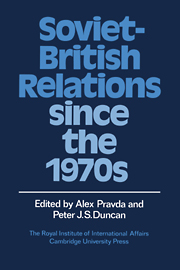Book contents
- Frontmatter
- Contents
- Contributors
- Acknowledgments
- 1 Introduction: pre-perestroika patterns
- 2 The historical perspective
- 3 Soviet perspectives on Britain and British foreign policy
- 4 British perspectives on the Soviet Union
- 5 The security dimension
- 6 Anglo-Soviet relations: political and diplomatic
- 7 The Soviet Union and the Left in Britain
- 8 Anglo-Soviet cultural contacts since 1975
- 9 Trade relations: patterns and prospects
- 10 Doing business with the USSR
- 11 Conclusions: Soviet-British relations under perestroika
- Index
11 - Conclusions: Soviet-British relations under perestroika
Published online by Cambridge University Press: 29 October 2009
- Frontmatter
- Contents
- Contributors
- Acknowledgments
- 1 Introduction: pre-perestroika patterns
- 2 The historical perspective
- 3 Soviet perspectives on Britain and British foreign policy
- 4 British perspectives on the Soviet Union
- 5 The security dimension
- 6 Anglo-Soviet relations: political and diplomatic
- 7 The Soviet Union and the Left in Britain
- 8 Anglo-Soviet cultural contacts since 1975
- 9 Trade relations: patterns and prospects
- 10 Doing business with the USSR
- 11 Conclusions: Soviet-British relations under perestroika
- Index
Summary
The last decade has seen the worst and the best of times in post-war relations between the Soviet Union and Britain. In the first five years relations plumbed depths unequalled since the early Cold War period; in the last five they have reached new heights. Since late 1987 both sides have agreed that the bilateral relationship is better than at any time since the war.
This dramatic shift in relations is evident, in varying degree, in all the dimensions of the bilateral relationship covered in the preceding chapters. Drawing on these chapters we shall focus on the thrust of change in the second half of the decade. As the chapter title suggests, we are interested in Soviet-British relations ‘under perestroika’ in two senses: the nature of changes which have occurred in the period associated with perestroika, and the extent to which such changes amount to a restructuring of the bilateral relationship. This involves considering the scope and depth of change in each of the major dimensions of relations; the factors shaping such change; and shifts in the overall configuration of relations. Assessing such issues may help us to evaluate the significance of recent and current changes. Are relations becoming less thin and fragile, less vulnerable to disruptive developments? It is as well to recall that previous upturns in relations, as in the mid-1970s, were hailed as remarkable improvements, only to be followed by a downward cycle. Do the changes of the last five years signal a departure from the historical pattern of oscillation highlighted by Curtis Keeble? To address these questions the following sections look at changing popular perceptions; the development of non-governmental and economic contacts; the course of political dialogue; diplomatic relations; and finally, the shifts in national elite images and perspectives that shape relations over the long term.
- Type
- Chapter
- Information
- Soviet-British Relations since the 1970s , pp. 232 - 256Publisher: Cambridge University PressPrint publication year: 1990
- 1
- Cited by



